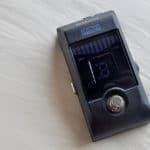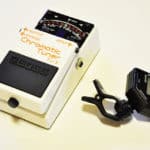Playing guitar is a soul-feeding activity.
It distracts us from our everyday problems.
It helps us concentrate on something useful, pursue a goal (such as playing in a band or wanting to learn your favorite tunes), and even make a living out of it.
However, a guitar is not a simple instrument.
Sure, you may understand the basics in just a matter of weeks or even days.
But the more you play, the more you realize there are hundreds of details to master.
Don’t be frustrated by this fact.
On the contrary, you should take that as a motivator and be fascinated by how rich the world of music is.
One of that basic details is to know when a guitar is in tune and when it’s not.
You’ll notice a guitar is out of tune because it sounds terrible. Chords will be dissonant, and if you play alongside a band, the entire song will feel off. The best solution is to have a tuner at hand to check and solve the problem easily. You may also tune in by ear if you know how to do it.
Stick with us to the end!
We’ll cover ways to solve this problem with and without a tuner, and much more.
Here we go!
Is there a way of knowing if a guitar is out of tune without a tuner?
The most effective way of noticing that a guitar is out of tune is by playing a chord.
Beginners could find this form a bit useless, especially if their ears are not yet too sharp.
However, it’s more probably that anyone will notice how bad a guitar chord sounds when out of tune.
Its sound is rather off. It’s unpleasant to anyone’s ears.
For more experienced guitarists, we recommend comparing strings by playing octaves.
For example, you can check whether the sixth string is in tune or not by playing the same note on the fifth string (in the 7th fret), or on the fourth one (2nd fret).
If they don’t sound okay, then that’s a clear sign one string is out of tune.
Watch out, because sometimes more than one string will be completely out of tune. So, comparing will not always be effective.
How can you know if a guitar is out of tune?
There’s yet another efficient form of realizing that a guitar is out of tune: using a guitar tuner.
It’s common to play a guitar whose strings are out of tune and not realize it at all.
This could be the case for rookie players, but also for more experienced ones.
In some cases, the difference is too little to notice at all.
So, a guitar tuner will show whether the string needs to be tuned or not.
But remember, the most accurate way is by simply listening to the instrument being played.
It sounds unpleasant? Then do something about it.
Can you damage a guitar if you play it out of tune?
Guitars cannot be damaged at all if played out of tune.
In fact, it’s common to play guitar on different tunings (and even some weird ones!).
For instance, you may play in drop D or drop C#, where the sixth string simply “contradicts” the rest of the tuning order.
These tunings are common and never imply any kind of danger to the guitar.
However, you should be careful if a guitar is out of tune due to the strings being higher.
In other words, if the strings stay too tight for extended periods, then the neck could bend, thus, causing some intonation problems.
But it’s unlikely to see any damage in a guitar caused by string tension.
Most common is having strings snapping all of a sudden.
Truth is, you shouldn’t worry about it at all. It’s uncommon for strings to go out of tune because they went higher unless you tuned them like that yourself.
What is the problem with playing a guitar out of tune?
The main problem with playing out-of-tune-guitars is that they sound horrible.
Seriously, an out-of-tune instrument will ruin any song. Not to mention, if you happen to play with other musicians, then you’ll simply affect the entire harmony.
Suppose you play a detuned guitar alongside a properly tuned bass. The contrast will be impossible not to notice.
We could also argue that, if you play with a detuned guitar and you never notice it, you could get used to that sound. As a result, you may “mislearn” how the guitar sounds in reality.
The worst thing that could happen is that those errors fossilize and become harder to correct in the future.
Other than that, there won’t be significant problems with playing a guitar out of tune.
As we said, the instrument won’t break or stop working in any way.
What can you do if you don’t know how to tune your guitar?
There are simple solutions to solve this issue.
The most obvious one is buying a guitar tuner.
To be honest, you don’t even need to pay for one at all. Simply download a tuning app to your smartphone and carry this tool wherever you go.
Even if you don’t know how to use a tuner, you shouldn’t really worry too much about it. After all, you can learn it in the blink of an eye.
Whenever you play a string, a note will ring. If this note is “wrong”, the tuner will show you.
Most tuners have a meter bar with an arrow that will move from right to left and from left to right. The goal is to leave that arrow in the middle.
When the string is in tune, the arrow will be in the middle of the bar, and the tuner will probably turn to green and make a sound to show you it’s already in tune (this last part depends solely on the type of tuner you use; will not always be the case for every tuner).
Bear in mind that sometimes the tuner will show you that the string is in tune, when in fact, it’s perceiving a different note.
For example, you need to tune the fourth string to D, but you tuned it all the way down to A. In this case, the tuner will decide that the string is in tune, but because it perceives the note as if it was the fifth string and not the fourth one.
If this seems like a hassle, don’t worry. You’ll get the hang out of it soon.
The other alternative is having an experienced guitarist tune the instrument for you.
Of course, this won’t always be the case. The best approach is to be willing to learn how to do it on your own.
So, ask when in doubt (no matter how many times you need to ask for it), but be attentive to your teacher or friend’s explanation.
Lastly, you can always look up a tutorial on Youtube.
Remember, if it seems too much, don’t despair. It takes some time to learn these details, so don’t worry if you fail at your first attempt.
The real failure would be not trying at all.
Easiest ways of tuning your guitar
Naturally, the simplest form of tuning a guitar is by using a guitar tuner.
We have previously covered how hard it is to tune by ear for beginner plays. But remember, even for experienced guitarists the difference could be too small to notice.
A tuner is always accurate, so there’s no way to fail with one.
You may also learn how to tune it by ear.
Sure, this is not the easiest way at all. On the contrary, tuning by ear requires lots of practice.
However, the more you try, the sooner you’ll learn to recognize a note that is in tune.
From that point on, you’ll find that tuning by ear is a piece of cake.
I discuss this topic in more depth here:

Hello there, my name is Ramiro and I’ve been playing guitar for almost 20 years. I’m obsessed with everything gear-related and I thought it might be worth sharing it. From guitars, pedals, amps, and synths to studio gear and production tips, I hope you find what I post here useful, and I’ll try my best to keep it entertaining also.





